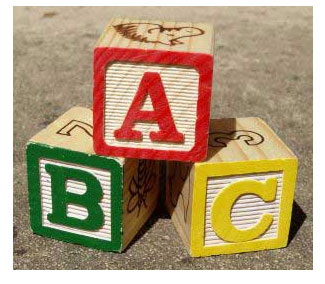A For over 200 years, there has been an interest in the way children learn to speak and understand their first language. Scholars carried out several small-scale studies, especially towards the end of the 19th century, using data they recorded in parental diaries. But detailed, systematic investigation did not begin until the middle decades of the 20th century, when the tape recorder came into routine use. This made it possible to keep a permanent record of samples of child speech, so that analysts could listen repeatedly to obscure extracts, and thus produce a detailed and accurate description. Since then, the subject has attracted enormous multi-disciplinary interest, notably from linguists and psychologists, who have used a variety of observational and experimental techniques to study the process of language acquisition in depth.
B Central to the success of this rapidly emerging field lies the ability of researchers to devise satisfactory methods for eliciting linguistic data from children. The problems that have to be faced are quite different from those encountered when working with adults. Many of the linguist’s routine techniques of enquiry cannot be used with children. It is not possible to carry out certain kinds of experiments, because aspects of children’s cognitive development – such as their ability to pay attention, or to remember instructions – may not be sufficiently advanced. Nor is it easy to get children to make systematic judgments about language, a task that is virtually impossible below the age of three. And anyone who has tried to obtain even the most basic kind of data – a tape recording of a representative sample of a child’s speech – knows how frustrating this can be. Some children, it seems, are innately programmed to switch off as soon as they notice a tape recorder being switched on.
C Since the 1960s, however, several sophisticated recording techniques and experimental designs have been devised. Children can be observed and recorded through one-way-vision windows or using radio microphones, so that the effects of having an investigator in the same room as the child can be eliminated. Large-scale sampling programmes have been carried out, with children sometimes being recorded for several years. Particular attention has been paid to devising experimental techniques that fall well within a child’s intellectual level and social experience. Even pre-linguistic infants have been brought into the research: acoustic techniques are used to analyse their vocalisations, and their ability to perceive the world around them is monitored using special recording equipment. The result has been a growing body of reliable data on the stages of language acquisition from birth until puberty.
D There is no single way of studying children’s language. Linguistics and psychology have each brought their own approach to the subject, and many variations have been introduced to cope with the variety of activities in which children engage, and the great age range that they present. Two main research paradigms are found.
E One of these is known as ‘naturalistic sampling’. A sample of a child’s spontaneous use of language is recorded in familiar and comfortable surroundings. One of the best places to make the recording is in the child’s own home, but it is not always easy to maintain good acoustic quality, and the presence of the researcher or the recording equipment can be a distraction (especially if the proceedings are being filmed). Alternatively, the recording can be made in a research centre, where the child is allowed to play freely with toys while talking to parents or other children, and the observers and their equipment are unobtrusive.
F A good quality, representative, naturalistic sample is generally considered an ideal datum for child language study. However, the method has several limitations. These samples are informative about speech production, but they give little guidance about children’s comprehension of what they hear around them. Moreover, samples cannot contain everything, and they can easily miss some important features of a child’s linguistic ability. They may also not provide enough instances of a developing feature to enable the analyst to make a decision about the way the child is learning. For such reasons, the description of samples of child speech has to be supplemented by other methods.
G The other main approach is through experimentation, and the methods of experimental psychology have been widely applied to child language research. The investigator formulates a specific hypothesis about children’s ability to use or understand an aspect of language, and devises a relevant task for a group of subjects to undertake. A statistical analysis is made of the subjects’ behaviour, and the results provide evidence that supports or falsifies the original hypothesis.
H Using this approach, as well as other methods of controlled observation, researchers have come up with many detailed findings about the production and comprehension of groups of children. However, it is not easy to generalise the findings of these studies. What may obtain in a carefully controlled setting may not apply in the rush of daily interaction. Different kinds of subjects, experimental situations, and statistical procedures may produce different results or interpretations. Experimental research is therefore a slow, painstaking business; it may take years before researchers are convinced that all variables have been considered and a finding is genuine.








